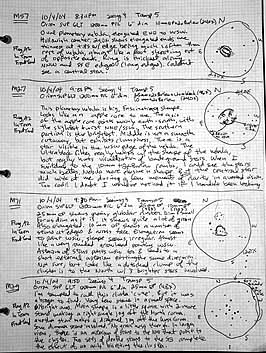I got a new section started in my sky journal for the New-and-Improved Messier records, made note of the things I had to take note of, and kept an eye on how the setting of the sun was progressing (a watched sun never sets, btw). Having seen Scorpius still low in the west for the past couple weeks, I decided to hunt there first before it scurries away for the winter. As the sun set, I started hauling out the gear and setting up the OTA for a cooldown. There's 3 main places I can observe in my front yard. The sidewalk outside the front door, which affords some distance from the street, and conveniently placed trees to block a couple unfortunate porchlights, but also a limited view to the low South. No good for Scorpius. So I considered location #2, the lawn. That gets me a good view of the South and Southwest, but the sprinklers would come on at 8:00, and that would be a real bummer (anybody ever lose an eye after flinching into a plössl?) So that left the middle of the driveway. A great view to the South and Southwest, but also in the splash zone for several porchlights. Oh well. Sacrifices.
As I was setting up, the next door neighbor, Paul, and his kid came over to see what was going on. I told them nothing about the secret death ray I was planning to unleash on the universe. But I did invite them to take a look after it got dark enough. As the sky got darker, my question of which part of Scorp to hit first was answered by a flat blot of clouds expanding out of the Southwest. A short time later, Paul wandered back over, and I had to demonstrate my ignorance. "Uh yeah, see how the clouds are covering that part there, and that part over there? Well that's where I was going to hunt. So now I gotta wait..." So you know what he says next, right? "Well what about over there? Or there?" as he pointed to non-cloud zones. Crud! Pop quiz! There were some clear spots west of Aquila. But my spur-of-the-moment comfort zones are Sagittarius, Scutum, Cygnus, Hercules, Sagitta, and Lyra were covered with strato-cumulus.
Feeling the pangs of frustration for not having anything to show him, I picked the whole contraption up and moved it over to the sidewalk where I had a view to the North. I did a quick slew over to the double cluster in Perseus (which turned out to be first (stellar) light through the new 32 mm Sirius Plössl, and a mighty fine view I might add). Paul's reaction was pretty much what I expected: "huh...yeah...I see that". My less-than-action-packed description of the clusters, and how there's a debate over whether they're gravitationally related or not, and how if you look long enough, you'll see some red stars in one of them, didn't do much to drag out any excitement. I think he needs a nice fat Jupiter or Saturn, or lunar terminator. Or a more informed guide ;-) Oh well. His son had a look next, and correctly answered '2' when I asked how many clumps of stars he could see :-D My daughter lifted my spirits though as she climbed up and took a look "I see it! ... It's beautiful!" Dadgummit that girl needs a raise in her allowance!
By now, the clouds were starting to lift away from the Southern horizon, and I hoped there might still be a little bit of Scorpius above the horizon to make some observations. So after bidding Paul good night, and better luck next time, I hefted the bazooka back over to the driveway and started squinting for any bright stars merciful enough to peek out from under the rising cloud blanket. It looked like the tail of Scorpius was going to peek out first, so I hit the Sky Atlas 2000 to see what I could dig up first. M7 and M6 looked to be likely candidates, hovering around Shaula. Glancing back and forth between the finder scope and the atlas, I realized that Shaula and 3 other stinger stars looked a lot like a sailboat with a huge rudder from my angle.
As I was about to move in for the kill, a hazy cloud smudged up the view. So I took a detour and just did some pleasure cruising to the Northeast, enjoying the 32 mm view along the way. I also enjoyed the neighbors across the street pulling up and turning on what must be a 200 watt porch light for the rest of the night. Pfeh! I made due cupping my hand across the eyepiece, and kept cruising. It wasn't long before I stumbled across a small globular cluster. Because clouds were still dancing around, I couldn't tell where I was in the sky, so I grabbed my journal and started sketching the field. I did a 10 mm and 32 mm sketch. One of the things I decided to do with globulars was to also draw my estimation of the brightness curve across the face of the cluster. For me, it seems like an easier way to depict the density of light across such a softly defined object. I noticed a bright neighboring star to the NW and a slight hint of elongation to the N and E.
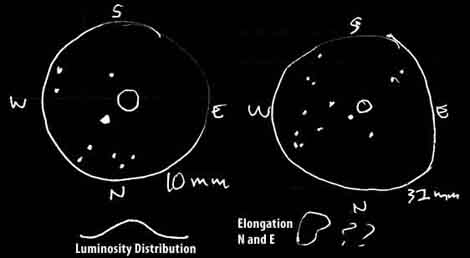
After finishing notes on the mystery glob, I moved back to the field around Shaula, which had cleared up...well, to the extent you can call the dim gray of urban sky glow 'clear'. I moved North from Shaula, viewing through the finder until I noticed a clot of stars I figured must be M7. Through the 32 mm eyepiece, it was a beauty. While not holding brilliant knockout punch of the Pleiades, this open cluster is still stunning. A smattering of outlying stars filled the 1.4 degree FOV, but there was a boundary of 4 bright stars arranged in a square that seemed to hold the bulk of the stars within. The SW star in the square was conspicuously red, and along the E edge of the square, a linear asterism of 6 stars reinforced that end like a spine.
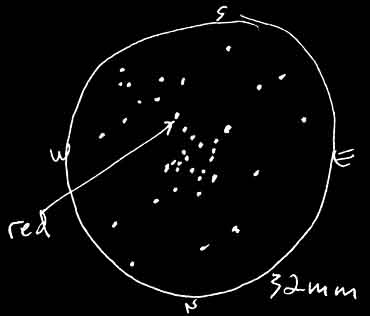
I moved the scope to the Northwest a bit until I hit what was definitely M6. A smaller open cluster, and much more granular than M7. Along the North side of the cluster, the shape of a parallelogram, like a little piece of Lyra, jumped out at me from 4 of the brighter stars. Like M7, one corner (NE) was graced with a red ember of a star.
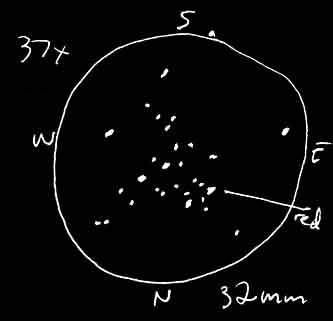
By now, Scorpius was diving pretty hard into the brightest sky glow on the horizon, so I gave up on trying to find M4 or M80. I'll save those for sometime later this week. I was also concerned to see Sagittarius taking the plunge into the horizon so early. I decided to take my search to the three globular Messier's at the bottom of the teapot. I moved in for M69 first--working my way West to East. As I moved East from Epsilon Sagitarii, a dim and rather familiar fuzzball came into view. I checked in both the 32 mm and 10 mm EPs and realized that M69 was the globular I had seen about 30 minutes earlier. So with a few strokes of my pen I scratched M 6 9 next to those notes.
And on Eastward I went. M70 came into view easily. Its luminous cross section was very similar to M69. Switching to the 10 mm EP seemed to show a brighter star dead center. Maybe that's a star, or maybe it's a bright spike at the core. I'm not sure.
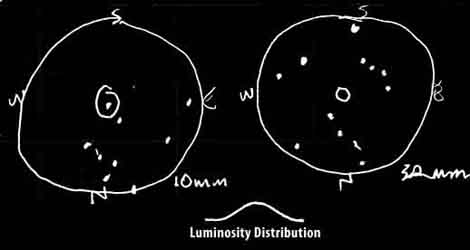
Finally, I moved East again and found M54. It was a brighter globular than M69 or 70 with a sharper luminous cross section. I couldn't resolve any stars with the 10 mm EP except for one point just a bit North of the center of the cluster.
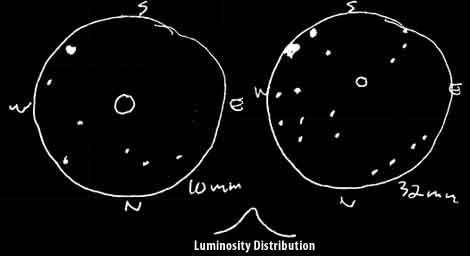
By now, the bulk of the teapot was swimming in city glow, like a speckled theater curtain lit by stage lights. I was a little irritated, because I really wanted to try out my new Ultrablock filter on the Sagittarius nebulas, and the sky was moving way too fast. I honed in on the Lagoon Nebula anyway. Through the 32 mm EP, it was the amazing wrinkle of soft light and stars I remembered it to be, but more concentrated due to the lower magnification. After taking that eyepiece out and inserting the 25 mm with the Ultrablock screwed in, I got a real treat. The detail of ridges and valleys in the nebula really popped out. Not only was the filter annihilating a ton of background light, but it was nailing way more detail than the last time I looked under darker skies. Very nice. This wasn't an official record for my Messier program though, just a pleasure stop. I want to spend more time on it under a little better sky conditions for that. After a little skimming around M20 and M16, I decided that Sagittarius was hosed for the rest of the evening. So I picked up my scope and moved over to the sidewalk for my Northern exposure.
Glancing between the morphing clouds, I finally spotted the keystone of Hercules, and moved in for a look at M13. Oh man, after spending all that time on the previous 3 shrimpy globulars, this was such a knock out. I know I just saw it a couple weeks ago, but it stands out so amazingly in comparison. I went from the 32 mm, to the 10 mm, and then to the 10 mm with a 2x Barlow, and nabbed more detail every time. Granted, the 240x view was pretty stinking dim, but it nailed dozens of individual stars across the surface of the cluster. I sketched the view in the 32 and 10 mm EPs The core luminosity rises soft and steady across the surface of the cluster with no evidence of a real hot spot in the middle. It seemed like I could make out some heavier spokes pointing SSE and SW, as well as a heavier glob of stars on the West side.
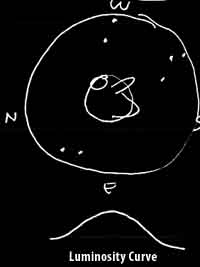
After taking a minute to glance around and see what was under threat of clouds, I settled on M33 in Triangulum. With the memory of Brent pointing it out with the Green Laser of Memorization, I lined up along the side of the OTA (the sky was too bright for hope of using the finder). When I peeked through the 32 mm eyepiece, the soft smudge of M33's core was right there staring back at me. Wahoo! I can see that booger from my front yard with lights shining all over the place. I decided to take a good long look and see if I could pull any structure out of it. With some concentration and moving the view around a bit, I finally decided that I could see a dim patch to the Southeast of the core, with a slight brightening again on the other side. Possibly one of the arms. Not what you'd call a sublime view, but definitely an observational treat.
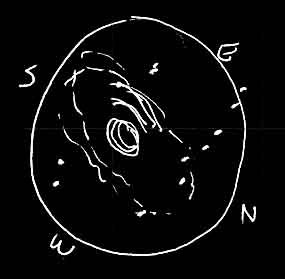
With just a little bit of slewing, I lined up on M31 in Andromeda. Once again, the comparison of M31 to M33 was like M13 to M69. Spectacular. I decided I was going to resolve something out of this galaxy if it took me an hour to do so. For as brilliant as this galaxy is, finding fluctuations in the brightness has been really difficult for me. But after panning around, and coming back to the core again and again, I finally started to notice a sharper drop in brightness on the West side of the core, and a swoop of dimness cutting into the Southwest side of the elongated body of the galaxy. I didn't really see 'dust lanes' per se, but I'm sure that's what they were. Hopefully, this will have me better tuned for the next time I view from a dark site, and I can pick up more. I managed to frame M31, M32 and M110 in the eyepiece for old times sake, but decided to wait until another time to analyze the other two further. I was getting cold you see. Cold and sleepy. What's more, the moon was rising far in the East, like a South Pacific nuke burning through horizontal layers of clouds.
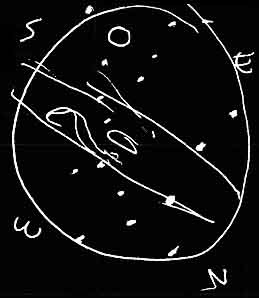
I had nearly everything packed up in the house when I realized I had forgotten one crucial bit of info. Seeing data. Arrrrgh!! So I brought the OTA and 10 mm EP back out and set it on the mount with no balance weights. Oy. I managed to hone in on a bright star I could get quick balance on and did my crummy version of a beginner's seeing estimate. 5 out of 10 (constant airy disc and occasional arcs of diffraction). So that was it. I brought all the cold metal parts inside and got everything arranged and put away. Too cool. I had my first 8 'official' Messier objects recorded, and it had me seeing things I don't think I would've noticed otherwise. Red stars people. They're everywhere.
By the way, here's a shot of how I've been recording observations up to this point...
